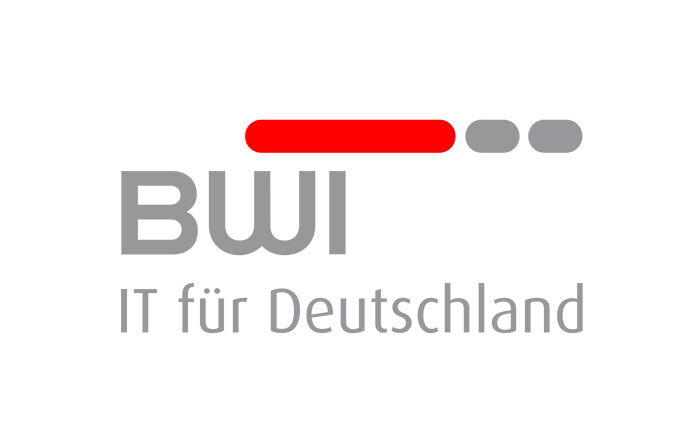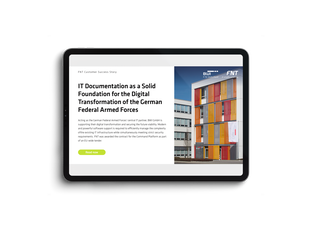
FNT Command as a Solid Foundation for the Digital Transformation of the German Federal Armed Forces

As central IT partner, BWI GmbH is supporting the digital transformation and securing the future viability of the German Federal Armed Forces. Modern and powerful software support is needed to efficiently manage the complexity of the existing IT infrastructure and at the same time meet the strict security requirements.
The solution of choice was FNT Command. It maps the infrastructures across all levels granularly and efficiently as a digital twin. This makes it much easier to manage the IT landscape and ensures stable and smooth operation.
Among other things, FNT Command will enable BWI to harmonize the tool landscape, achieve a high degree of standardization and significantly improve data quality. In this way, the solution supports BWI in the digitalization of the Federal Armed Forces and creates a basis for driving forward automation.
BWI GmbH
BWI is the German Federal Armed Forces’ primary digitalization partner and IT system house. It provides stable, secure, and efficient IT services – at home and abroad, from basic operations to the operational area. In this way, it contributes to continuously increasing the command and operational capability and combat strength of the German armed forces. With more than 7000 employees, it operates and develops the IT of the German armed forces. As a partner of the German Federal Armed Forces, BWI supports the digital transformation of the armed forces towards modern standards, industry-standard processes, and a harmonized software landscape. BWI is a development partner for new applications, but also offers needs-based services. These include the design and implementation of applications as well as IT operations and 24/7 IT support throughout Germany. BWI GmbH generated a revenue of 1.68 billion euros in 2023 and is one of the top 5 internal IT service providers in Germany. It is a wholly owned federal company and was recognized as a “Great Place to Work” in March 2024.


Complex IT Landscape with High Security Requirements
As a wholly-owned subsidiary of the federal government, BWI is responsible for the secure operation and further development of the armed forces' IT landscape which comprises around 5 million IT assets spread across five data center locations and more than 1,000 properties. Modern and powerful software is required to efficiently manage the associated complexity and strict security requirements.
BWI – Facts and figures
- Managed IT systems: more than 5 million assets
- Fiber optic WAN: 13,000 km
- Speed: with 100 Gbit/s, BWI operates the fastest fiber optic connections in Germany
- Servers: around 11,800 (hardware and virtual servers)
- Telephones / smartphones: 250,000
IT documentation and infrastructure management according to modern requirements
The previous documentation solution, which BWI used to manage some of the systems and assets, had served the company well for many years. However, the solution needed to be modernized. After much deliberation, the team decided to retender the software for IT documentation and infrastructure management in line with modern requirements. At the same time, BWI aimed for company-wide harmonization and standardization.
FNT GmbH was awarded the contract with its FNT Command platform, which offers great potential thanks to an open interface connection, numerous functionalities and a high degree of standardization. The platform also offered the opportunity to standardize data and processes company-wide in the future with a tried-and-tested central tool.
The Implementation - Four Phases to the Finish Line
1. Analysis of the current situation and recording of all objectives and systems
- Analysis of processes in the legacy system
- Documentation of the workflows
- Identificatoin of use cases
- Development of a detailed catalog of requirements
- Definition of the required roles and rights management
- Identification of the required data fields in the database
- Recording of all systems that need to be connected to the FNT Command Platform
- Creation of a training plan for employees
2. Design of the target system
- Elaboration of the design of the target system
- Creation of the appropriate migration concept
3. Implementation and migration of data
- Definition of the basic configuration and master data types
- Migration of initial master data into the system
- Cleansing and standardization of data
- Provision of the IT system infrastructure
4. Introduction and training
- Conceptual development of the required training activities
- Definition of training participants, training content, formats and materials
- Identification of manuals and documentation required to support the system

Particularities of the German Federal Armed Forces
The specific challenge was to ensure the highest possible level of data security and protection. Many security-relevant requirements originate directly from the BSI and IT baseline protection, but some also come from the German Federal Armed Forces and BWI itself. For example, all communication must be encrypted; the login for administrators is secured by multiple authentications. The trick here is to balance the implementation in such a way that usability does not suffer too much.

Why FNT?
Simple integration of third-party systems
Third-party systems can be integrated easily, flexibly and dynamically via FNT Command's open API. FNT Command ultimately forms the single source of truth - the collection point - for this data and thus enables the holistic visualization of all infrastructure levels and areas, including their dependencies. As many third-party systems are to be connected to FNT Command, the team expects a major advantage over the legacy system in this respect and a high savings potential.
Completeness and transparency of data
Thanks to the clear structuring and preparation of data, the FNT Command Platform enables efficient management of IT services. Information on all customer-related technical services, including all service assets and their entire lifecycle, is documented and historicized in the database.
Digitization and automation
The long-term goal is to significantly increase the level of automation and, for example, to completely digitalize order and incident management. In this way, BWI aims to accelerate IT operating processes and at the same time further increase operational efficiency. The system also contributes to this with its comprehensive functionality, high degree of standardization and extensive configuration options. The IT documentation tool will be used without any customizing from the software manufacturer. This makes release updates significantly easier and they can be rolled out relatively easily.
Hochverfügbarer Betrieb in Privater Cloud
FNT Command läuft in den Rechenzentren der Bundesagentur auf virtuellen Servern und wird als Live-Dokumentationstool verwendet. Das heißt: Die IT-Mitarbeitenden tragen die vorher geplanten Anpassungen vor der Umsetzung in die CMDB ein. Die Qualitätssicherung übernimmt die Veränderungen anschließend als neuen Ist-Zustand. Daher ist eine nahezu 100-prozentige Hochverfügbarkeit von FNT Command unabdingbar. Die Bundesagentur für Arbeit stellt diese über einen redundanten Betrieb und Load-Balancer sicher.
Tagtäglich nutzen etwa 50 bis 100 Mitarbeitende FNT Command (von ca. 1.800 Mitarbeitenden des IT-Systemhaus insgesamt). Die meisten verwenden die Plattform rein zu Informationszwecken mit einem Nur-Lese-Zugriff.
Aktuell arbeitet das IT-Systemhaus gemeinsam mit FNT an der Anbindung von Command an das Beschaffungsmanagementsystem von SAP, um Bestellungen aus der IT-Planung ausführen zu können. Um die Toollandschaft besser zu konsolidieren, wird das bisherige Bestandsführungstool mit SAP-Anbindung für die Rechenzentrumsverwaltung von FNT Command abgelöst. Die neue Lösung berücksichtigt dann auch die aktuellen Lagerbestände und löst Bestellungen über das Order-Management nur dann aus, wenn die Artikel nicht vorrätig sind oder der Lagerbestand unter einen bestimmten Level fällt. Die Verbindung zu SAP ist dabei bidirektional. Wenn die bestellte Ware eintrifft, wird diese Information wieder in FNT übernommen und entsprechend vermerkt (um die Planung ausführen zu können). So lässt sich beispielsweise auch der Wartungsvertrag mit vielen Details für ein bestelltes Produkt in FNT Command betrachten.
Die Integration mit SAP erspart den Beteiligten die Nachverfolgung der bestellten Waren in verschiedenen Systemen und auch das Management der Artikel im Lager. Gibt es Veränderungen an der Planung, löst dies automatisch entsprechende Aktionen in den anderen Systemen aus, ohne dass manuell nachverfolgt werden muss. Selbst Stornierungen von Bestellungen sind über einen einfachen Dialog in FNT Command möglich – ein Wechsel zu SAP ist dafür nicht notwendig. Der Go-Live der Integration des neuen Systems erfolgte im Juli 2023.
Vorteile der neuen Lösung
Durch die Zentralisierung der IT-Dokumentation konnten viele Vorgänge automatisiert werden, die vorher manuell durchgeführt werden mussten. Durch die automatisierte Planung entfallen viele manuelle Planungstätigkeiten wie etwa die Suche nach freien Ports in Racks. Dies übernimmt nun FNT Command. Dadurch erhöht sich zwar der Planungsaufwand im Vorfeld von Veränderungen minimal, spart aber vor Ort viel Zeit ein, weil nichts mehr gesucht oder erst analysiert werden muss. Durch die Umstellung der Prozesse auf die Live-Dokumentation innerhalb von FNT Command ist die Zahl erforderlicher Korrekturen fast auf Null reduziert worden.
Vielfach genutzt und als sehr hilfreich sieht die Bundesagentur für Arbeit auch die Funktion „Easy Search“, mit der sich wie mit einer Suchmaschine nahezu alle indizierten CIs schnell und einfach finden lassen. Damit lässt sich jedes IT-Gerät und Kabel in wenigen Sekunden lokalisieren und alle dazu hinterlegten Informationen abrufen.
Durch die Anbindung externer Systeme für die IT-Clients und die Raumverwaltung in den Niederlassungen kann FNT Command regelmäßig Skripte ausführen, um Unstimmigkeiten in der Verortung der Clients zu finden und automatisiert Tickets erstellen, damit die Daten aktualisiert werden.
FNT Command findet bei den IT-Mitarbeitenden eine hohe Akzeptanz, auch weil es sich flexibel an andere Systeme anbinden lässt und weil viele wichtige Funktionen bereits in einem großen Umfang out of the box vollständig in der Software implementiert sind. Es gibt eine Vielzahl an Modulen, die schon in der Standard-Ausbaustufe viele Datenhaltungsprobleme lösen, für die Mitarbeitende sonst Excel verwendet oder eine Datenbank aufgesetzt hätten.
Ein besonderer Vorteil ist die Offenheit beim Datenaustausch. So ist es nicht nur möglich, Daten aus anderen Systemen nach FNT Command zu übernehmen, dies bei Bedarf flexibel und mit Bordmitteln zu erweitern und die Daten verschiedener Quellen logisch zusammenzuführen. Das Tool stellt über verschiedene Protokolle alle Daten auch wieder zur Verfügung – eine Funktionalität, die viele andere Systeme nur rudimentär unterstützen. Das erleichtert die Anbindung an angrenzende Bestands-, Monitoring- oder DCIM-Systeme enorm.
Planung als Kernfunktion
Ein maßgeblicher Grund für die Einführung von FNT Command war und ist aus Sicht der Bundesagentur für Arbeit die umfassende Planungsfunktionalität. Sie erlaubt es, einen Zielzustand zu erarbeiten und alle dafür notwendigen Schritte strukturiert und in weiten Bereichen automatisiert auszuarbeiten, beispielsweise Anweisungen für Dienstleister zu erzeugen, Beschaffungsaufträge zu generieren und an ein ERP-System zu übergeben. Auch die Übernahme des projektierten Soll-Zustands als neuen Ist-Zustand spart enorm viel Erfassungsarbeit und erhöht die Zuverlässigkeit der Lösung. Insgesamt hat sich die Übersicht und Transparenz über die gesamte IT-Infrastruktur bei der Bundesagentur enorm verbessert, was viele Services stark beschleunigt. Zusammen mit den umfangreichen Managementfunktionen von FNT Command hat dies den Arbeitsalltag der IT-Mannschaft sehr positiv beeinflusst.
Über FNT
Die FNT GmbH mit Hauptsitz in Ellwangen (Jagst) vereinfacht mit ihrer FNT Command Platform das Management von hochkomplexen digitalen Infrastrukturen in Unternehmen und Behörden. Sowohl IT-, Telekommunikations als auch Rechenzentrumsinfrastrukturen lassen sich mit der Cloud-fähigen „Software made in Germany“ effizient als Digitaler Zwilling erfassen und über alle Ebenen vom Gebäude bis zum digitalen Service dokumentieren. Die Software bietet zudem offene Schnittstellen und zahlreiche Funktionen, um Transformationen und Changes integriert zu planen, umzusetzen und zu automatisieren. Zu den Kunden von FNT zählen mehr als 500 Unternehmen und Behörden weltweit, darunter mehr als die Hälfte der im DAX-40 notierten Konzerne. FNT betreibt Niederlassungen an mehreren Standorten in Deutschland sowie in New York, London, Singapur und Timisoara und verfügt über ein internationales Partnersystem mit den marktführenden IT Service Providern und Systemintegratoren.

